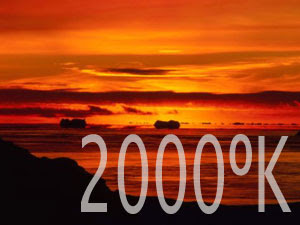From the glow of dawn to the brilliance of midday, from the cast of twilight to the exuberance of sunset, the constantly changing color of natural light is part of our existence. As I explained in my previous post, there is no formal definition of "true" color. When we view objects under different types of light sources, we notice differences both in the light itself and in the way surfaces are rendered under these different light sources. Whether the light comes from a natural or an artificial source, each spectral distribution distorts colors. Color quality remains very subjective, and the existing measures of color quality created to allow comparing and evaluating light sources are far from perfect.
As I hinted above, the color quality of light has two parts. The most obvious part is whether the light appears “warm” or “cool” and is expressed by the Color Temperature of the source. The other part is the ability to reveal the relationship between colors and is referred to as the Color Rendering of the source.
The Color Temperature of a light source describes the color of white light, its yellowness or blueness, its warmth or coolness. The term temperature refers to the real temperature of a physics concept called ‘black body’. The everyday equivalent of this concept can be seen in materials such as iron, which gradually glows when heated. Their color change as a function of temperature: first red, then orange, then yellow up through white and blue. The temperature of the material which corresponds to those colors is termed the color temperature, and is measured in degrees Kelvin (K) on an absolute temperature scale.
The Color Temperature does not define how natural or unnatural the colors of objects will appear when lighted by the source. Two light sources can have the same Color Temperature, but render colors very differently. For example, fluorescent lamp may have about the same Color Temperature as do high power incandescent lamps, but they have far less red energy in their spectrum. Therefore, red colors will not appear as bright as they would under incandescent lighting.
To help indicate how colors will appear under different lighting conditions, a measure has been adopted to assist in comparing between different light sources. Called the Color Rendering Index (CRI), it is a relative comparison between a light source and a reference source.
A simple definition of CRI would be how an artificial light source shifts the location of eight specified colors as compared to the same colors lighted by a reference source of the same Color Temperature. If there is no change in appearance, the light source is by definition given a CRI of 100. From 2000K to 5000K, the reference source is the ‘black body’ and above 5000K, it is an agreed upon form of daylight.
There are several limitations to CRI. First of all, it is a simple scalar value and it is difficult to believe that a single measure can reveal everything about the quality of a light source. Light is a rich space of hue, saturation and brightness, in which light sources with vastly different spectral distributions can have identical CRI values yet render colors in very different ways.
Because it contains substantial distortion, especially in the red region, the color space used for CRI calculations has become obsolete. With only eight colors, the set of reference colors provides a rather reductive sample of colors given the breadth of the visible spectrum. Furthermore, it lacks the richer saturated colors, even if observation reveals that the most dramatic color shifts occur in the saturated colors!
A common misunderstanding is that high CRI means that the light source will render all colors well. This is not the case. CRI is measured only with respect to a reference source. For the comparison to makes sense, the reference must be the closest in color to the source being tested.
Another mistaken impression is that a higher CRI value comes closest to approximating natural daylight, but this is incorrect. There is no single measure of natural daylight as the color of the sky and the light from it can vary significantly over the course of a day and according to the viewer position.
Incandescent lamps have a CRI rating of 100, yet are far from ideal for color rendering. Their CRI value simply means that the 8 color samples look exactly the same as they would under a "black body" radiator at 2700K. But at this Color Temperature incandescent lamps are far too weak at the blue end of the spectrum, making it almost impossible to distinguish between various shades of blue. The same can be said for light sources with Color Temperature above 6000K as they are too weak in the red end of the spectrum, making reds and oranges appear similar. The northern sky with its 7500K and a CRI of 100 is not a good color rendering light source either. An “ideal” light source for color rendering will have both a Color Temperature similar to daylight, i.e. in the 5000-6000K range, and a high CRI value.
In a way, the CRI measurement method attempts to quantify a subjective notion, and as many such attempts is far from giving reliable results. To further support the subjective nature of CRI, in one study LED light sources were compared to reference light sources. It turned out the LED light sources were preferred over halogen and incandescent light sources for overall color appearance and that CRI had no correlation to people’s color preference.
To avoid specious marketing strategies, the educated consumer need only remember that Color Temperature isn't by itself a metric of performance. It is typically a specification of the type of light source, and is used to describe the color of white light.
On the other hand, the Color Rendering Index is the metric used to compare the color quality of light sources until a new and accepted measure is developed. However, CRI is controversial and presents several deficiencies, especially with respect to LED sources.























